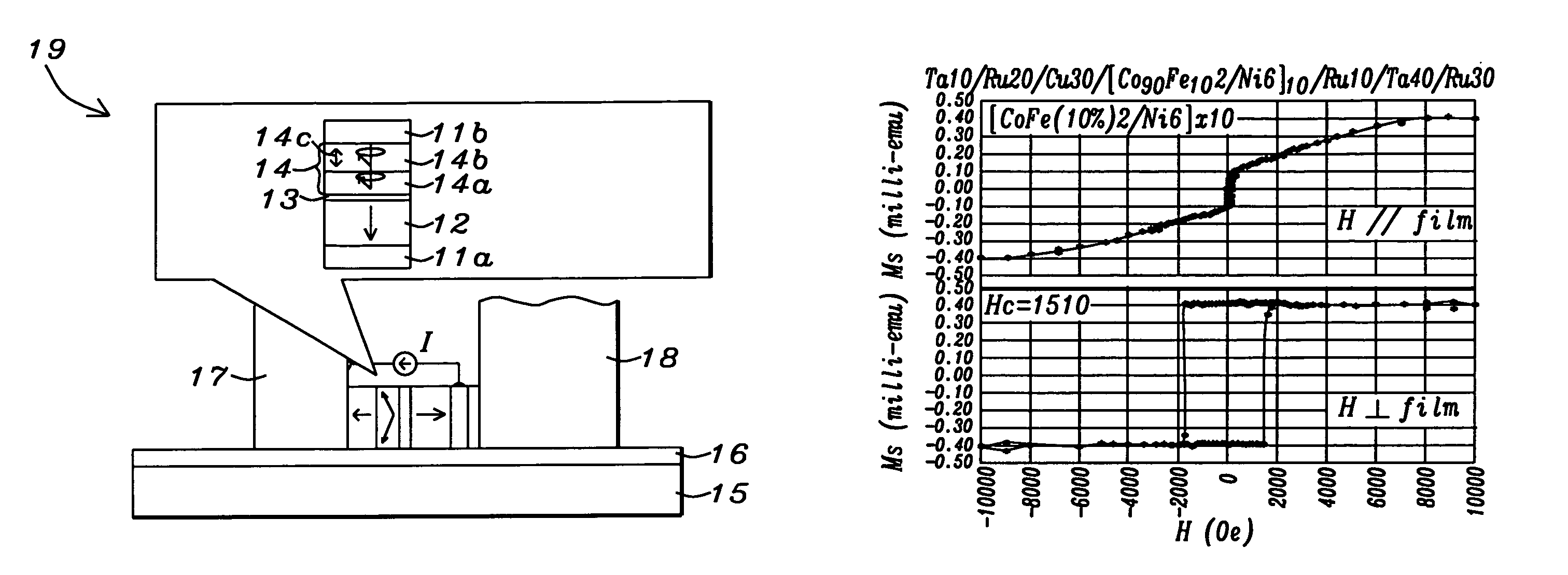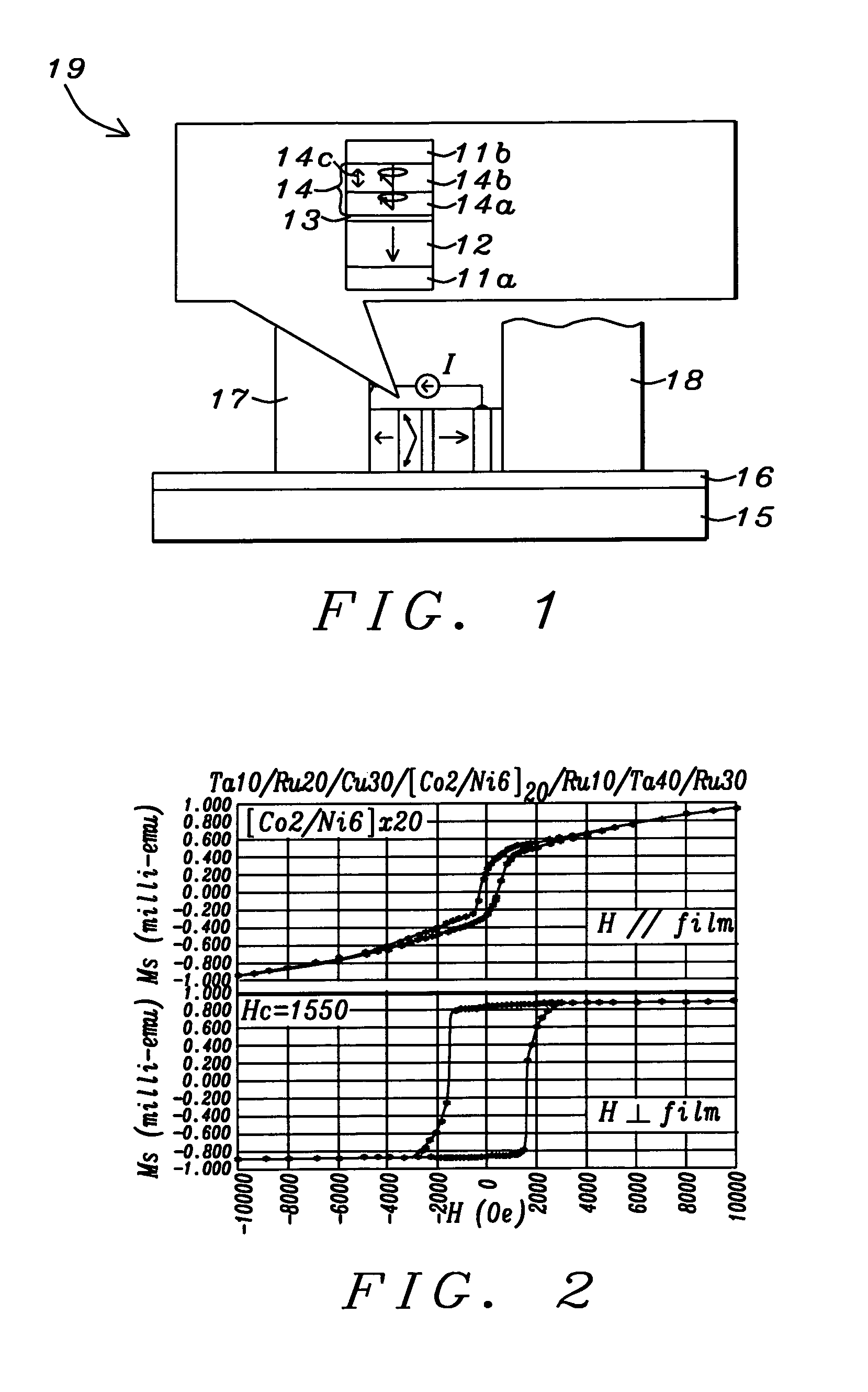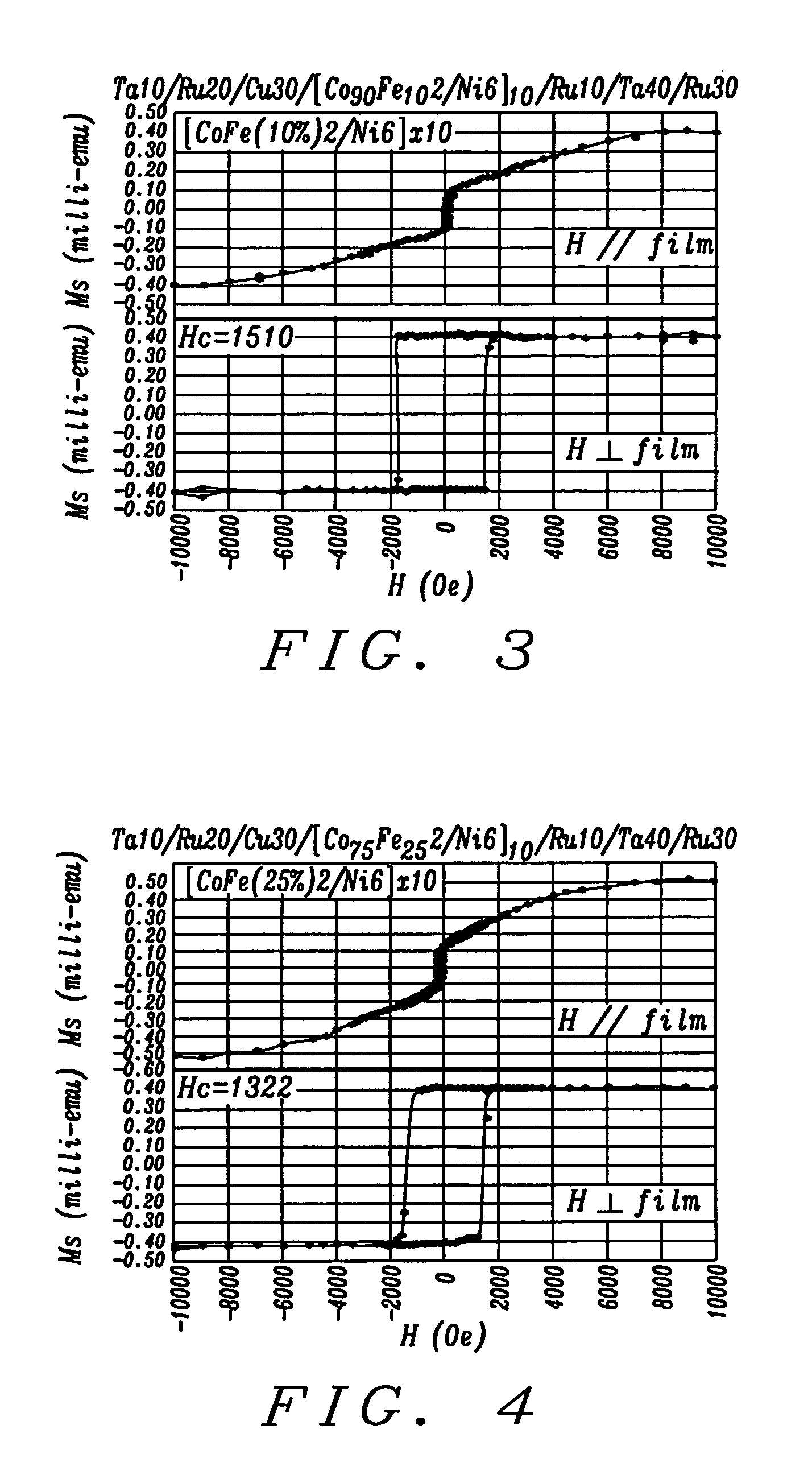CoFe/Ni Multilayer film with perpendicular anistropy for microwave assisted magnetic recording
a multi-layer film, perpendicular anistropy technology, applied in the direction of magnetic bodies, head surfaces, instruments, etc., can solve the problems of inability to integrate devices, all literature examples suffer from at least one drawback, and the use of external magnetic fields generated by current carrying lines to switch the magnetic moment direction becomes problematic, etc., to achieve the effect of improving the robustness of the sil, improving the mr ratio in the spin valve, and improving the robustness
- Summary
- Abstract
- Description
- Claims
- Application Information
AI Technical Summary
Benefits of technology
Problems solved by technology
Method used
Image
Examples
example 1
[0060]A series of STO structures comprising a bottom SIL configuration was fabricated to provide examples of the first embodiment. The bottom SIL configuration is represented by Ta10 / Ru20 / Cu20 / [Co(100-Z)FeZ2 / Ni5]X / spacer / FeCo100 / Ru10 / Ta40 / Ru30 where the number following each layer is the thickness in Angstroms. Ta / Ru / Cu is employed as the seed layer, FeCo100 is the FGL, and a (CoFe2 / Ni5)X laminate is the SIL in which each CoFe layer is 2 Angstroms thick and each Ni layer is 5 Angstroms thick and x is maintained between 5 and 50. Fe content in the CoFe laminated layers is kept between 0 and 90 atomic %. A Cu or another metallic spacer is employed for CPP-GMR applications while a AlOx, MgO, TiOx, TiAlOx, MgZnOx, or ZnOx spacer is used for CPP-TMR structures. The capping layer is a Ru10 / Ta40 / Ru30 composite. Based on torque measurements, we deduced that Hk for each (CoFe / Ni)X stack is >15000 Oersted (Oe).
example 2
[0061]A preferred bottom SIL configuration was fabricated and is represented by Ta10 / Ru20 / Cu20 / [Co100-Z)FeZ2 / Ni5]X / spacer / [Co(100-Z)FeZ2 / Ni5]Y / FeCo100 / Ru10 / Ta40 / Ru30. This structure is a modification of the first embodiment where a (CoFe / Ni)Y laminate is inserted between the non-metallic spacer and the FeCo100 layer to give a composite FGL where y is between 5 and 30. Since the [Co(100-Z)FeZ2 / Ni5]Y laminate has a strong magnetic coupling with the FeCo100 layer, the large PMA of the [Co(100-Z)FeZ2 / Ni5]Y laminate will force the anisotropy of the FeCo to tilt partially toward the perpendicular to plane direction so that the entire FGL can easily oscillate under a low current density.
example 3
[0062]A series of STO structures comprising a top SIL configuration was fabricated according to another embodiment of the present invention. The top SIL configuration is represented by Ta10 / Ru20 / Cu20 / FeCo100 / spacer / [Co(100-Z)FeZ2 / Ni5]X / Ru10 / Ta40 / Ru30 where the number following each layer is the thickness in Angstroms. Ta / Ru / Cu is employed as the seed layer, FeCo100 is the FGL, and a (CoFe2 / Ni5)X laminate is the SIL in which each CoFe layer is 2 Angstroms thick and each Ni layer is 5 Angstroms thick and x is maintained between 5 and 50. Fe content in the CoFe laminated layers is kept between 0 and 90 atomic %. Cu or another metallic spacer is employed for CPP-GMR embodiments while a AlOx, MgO, TiOx, TiAlOx, MgZnOx, or ZnOx spacer is used for CPP-TMR structures. The capping layer is a Ru10 / Ta40 / Ru30 composite. Based on torque measurements, we deduced that Hk for each (CoFe / Ni)X stack is >15000 Oersted (Oe).
PUM
| Property | Measurement | Unit |
|---|---|---|
| thickness | aaaaa | aaaaa |
| thickness | aaaaa | aaaaa |
| thickness | aaaaa | aaaaa |
Abstract
Description
Claims
Application Information
 Login to View More
Login to View More - R&D
- Intellectual Property
- Life Sciences
- Materials
- Tech Scout
- Unparalleled Data Quality
- Higher Quality Content
- 60% Fewer Hallucinations
Browse by: Latest US Patents, China's latest patents, Technical Efficacy Thesaurus, Application Domain, Technology Topic, Popular Technical Reports.
© 2025 PatSnap. All rights reserved.Legal|Privacy policy|Modern Slavery Act Transparency Statement|Sitemap|About US| Contact US: help@patsnap.com



